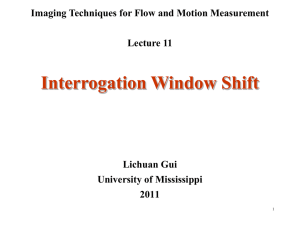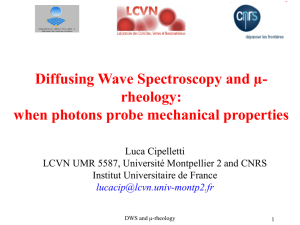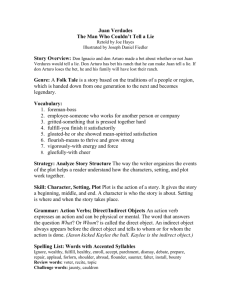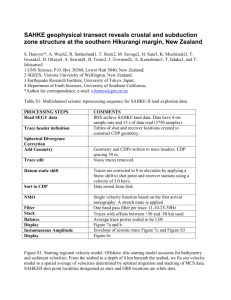Francoise_Ch_12_comments
advertisement
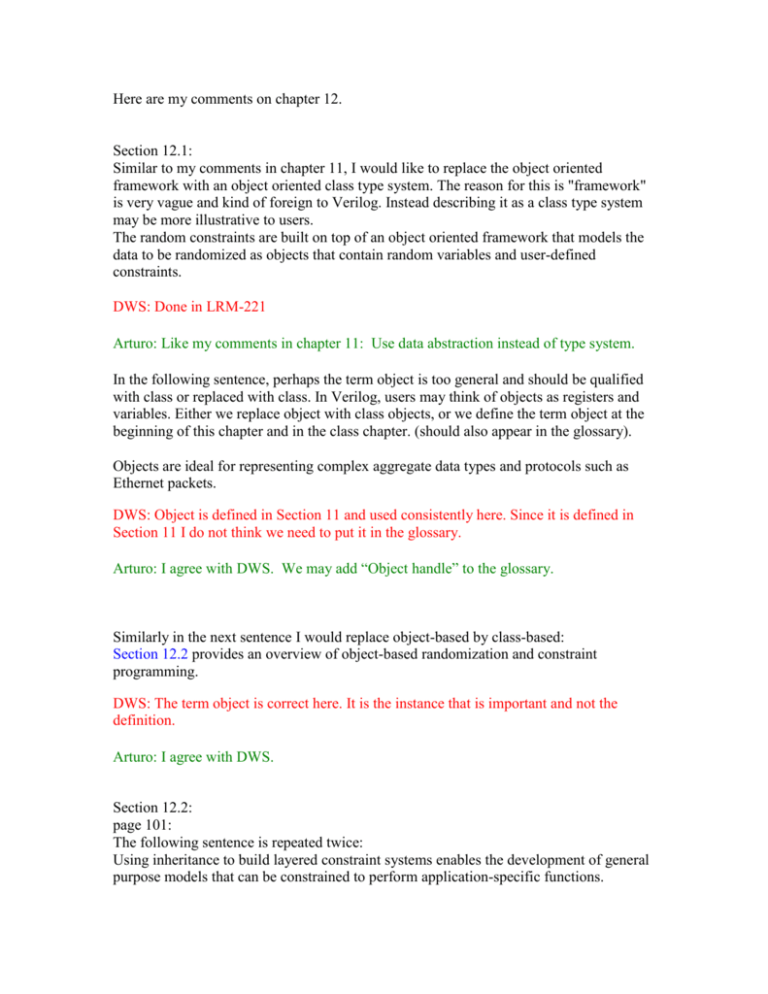
Here are my comments on chapter 12.
Section 12.1:
Similar to my comments in chapter 11, I would like to replace the object oriented
framework with an object oriented class type system. The reason for this is "framework"
is very vague and kind of foreign to Verilog. Instead describing it as a class type system
may be more illustrative to users.
The random constraints are built on top of an object oriented framework that models the
data to be randomized as objects that contain random variables and user-defined
constraints.
DWS: Done in LRM-221
Arturo: Like my comments in chapter 11: Use data abstraction instead of type system.
In the following sentence, perhaps the term object is too general and should be qualified
with class or replaced with class. In Verilog, users may think of objects as registers and
variables. Either we replace object with class objects, or we define the term object at the
beginning of this chapter and in the class chapter. (should also appear in the glossary).
Objects are ideal for representing complex aggregate data types and protocols such as
Ethernet packets.
DWS: Object is defined in Section 11 and used consistently here. Since it is defined in
Section 11 I do not think we need to put it in the glossary.
Arturo: I agree with DWS. We may add “Object handle” to the glossary.
Similarly in the next sentence I would replace object-based by class-based:
Section 12.2 provides an overview of object-based randomization and constraint
programming.
DWS: The term object is correct here. It is the instance that is important and not the
definition.
Arturo: I agree with DWS.
Section 12.2:
page 101:
The following sentence is repeated twice:
Using inheritance to build layered constraint systems enables the development of general
purpose models that can be constrained to perform application-specific functions.
DWS: Fixed in LRM-222
Arturo:OK.
Q: is it allowed to call .randomize method if the class has no random constraint variables?
Does this result in a runtime error?
DWS: I would expect that if you call it nothing happens. If you wish to make it an
implementation error or warning that might be useful but it is well defined.
FM: I guess we could leave it unspecified and leave it to the vendors to issue a warning.
Arturo: It really is unspecified. Implementations may generate an error at elaboration
time or call a randomize method that does nothing. Note the latter implies a certain
amount of overhead since every class might have to implement a virtual randomize
method. In either case, there should be no run-time errors.
In the following example, there is no pre_randomized or post_randomize methods in the
class XYZ. What is then the effect of calling super.pre_randomize?
Is it a legal example?
The "endtask" in the example should be removed.
class XYPair;
rand integer x, y;
endclass
class MyYXPair extends XYPair
function void pre_randomize();
super.pre_randomize();
$display("Before randomize x=%0d, y=%0d", x, y);
endfunction
function void post_randomize();
super.post_randomize();
$display("After randomize x=%0d, y=%0d\n", x, y);
endtask
endfunction
DWS: LRM_96 takes care of the syntax errors. The text describes pre_randomize
and post_randomize as being built-in methods that can be overloaded. This means
they exist (and do nothing). The example is correct since the implementation of
MyYXPair needs to call the parent ones so that if they are overloaded in the future
they behave as required.
See the paragraph after the example.
FM: understood now,
Section 12.3 random Variables:
— The solver can randomize scalar singular variables of any integral type such as
integer, enumerated types, and packed array variables of any size.
Q: what about packed structs, associative arrays, dynamic arrays, If these are included in
integral types, we should remove the such as...
DWS: Remove “such as clause” in LRM-223.
Note that both singular and integral should appear in the glossary.
DWS: For later since they are defined in the LRM in other places.
Arturo: I agree with DWS.
I don't understand the following sentence:
If the array elements are object handles, all of the array elements must be non-null.
Individual array elements can be constrained, in which case the index expression must be
a literal constant.
Q: Why are all array elements of an associative array required to be non null?
Q: is the last sentence (the index expression must be a literal constant) addressing both
associative and dynamic arrays?
Q: if you have an array of packed struct S, and you randomize the array:
myarr.randomize (does it randomize the individual struct elements (S.a, S.b) even if
each struct element is not declared as rand?
Arturo:
1. All array elements must be non-null since the solver can’t randomize a null object .
2. Yes. The constant index applies to associative and dynamic arrays
3. If the array of packed struct is declared rand then each element of the array is
randomized.
An object handle can be declared rand in which case all of that object’s variables and
constraints are solved concurrently with the variables and constraints of the object that
contains the handle.
Objects cannot be declared randc.
Q: does this also applies to packed structs
Arturo:
No. Packed structs can be declared randc.
Q: How do you randomize a packed union? do you provide random values for each one
of the union members? or you have to specify a single union member?
Arturo:
All the bits that make up the union are randomized. This can be modified by specifying
constraints for different union members.
Section 12.4.1 external constraint blocks
Constraint block bodies can be declared outside a class declaration, just like external task
and function bodies
Q: Please define exactly in which declarative context can a constraint block appear.
Q: Does the class it constrains need to be visible?
Q: Can it constrains a class which is referred to by an XMR such as:
constraint top.mod.XYPair::c { x < y; }
DWS: I have sent these questions to Arturo and Mehdi for responses. These questions are
surprising since we have had two reviews in the EC and they did not come up. Good
questions but a little late.
FM: Sorry to send these questions a little too late but it took me a few times reading
through this chapter and only at the last reading I could think about the details. It takes
time to get a global understanding of classes, constraints, program blocks and assertions
which all together are necessary to be able to get a feel on how to use this stuff.
Arturo: I understand what you are saying. There is a lot of material.
1. The constraints need to be defined (the bodies I assume) in the same scope as the
class declaration.
2. Yes. The class needs to be visible (but with elaboration everything is visible).
3. No. This is related to the first question. However, a nested scope can be used.
Section 12.4.3:
value_range_list is a comma-separated list of integral expressions and ranges. Ranges are
specified with a low and high bound, enclosed by square braces [ ], and separated by a
colon ( : ), as in [low_bound:high_bound]. Ranges
Verilog also ranges for part select expressions specified as [0+:3] and [3-:3] , why isn't it
allowed here?
DWS: Did not come up in committee. Have to bring up in next version of SystemVerilog
since this is a semantic change.
FM: fine.
Arturo: Interesting enhancement. The value-range is more general than SystemVerilog’s
part select syntax. The low/high bounds can be variables so there’s no need for a fixed
width, variable origin construct. It’s still interesting, though.
I think we should add that the expressions or value ranges must be compile time
determinable (not dynamic).
Arturo: There’s no such restriction (note the BNF has been changed)
The title of this section talks about the set membership operator but it is not clear what is
this operator? Is it inside?
A formal definition of what is the set membership operator is needed.
DWS: The BNF in 12.4.2 clearly show the operator as inside as does the operator table in
7.9. The definition is actually quite formal. What suggestions or changes do you have
(too late now for 3.1 but for later…).
FM: I think I was looking for a paragraph title change to set membership operator: inside
same for next section :
distribution operator: dist
Arturo: The set-membership operator is inside. I don’t see the confusion.
Section 12.4.4 page 107
Replace: The distribution operator dist evaluates to true if the expression is contained in
the set; otherwise it evaluates to false.
WIth:
The distribution operator dist evaluates to true of the value of the expression is contained
in the set, otherwise it evaluates to false.
Because the expression is not contained in the value set, but the value of the expression
should be.
DWS: Fixed in LRM-224
Arturo: OK.
Optionally, each term in the list can have a weight, which is specified using the := or :/
operators. If no weight is specified, the default weight is 1. The weight can be any
integral SystemVerilog expression.
Q: What occurs if the same value has 2 different weights; is it allowed?
DWS: The answer is for example x dist {100 := 1, 100 := 2, 300 := 5} would result in
100 be 3 out of 8 and 300 being 5 out of 8. No problem. It is allowed.
FM: I think we should add that you can specify several weights for the same and they are
cumulative weights.
Arturo: DWS is right. It seems straightforward to me. Why would anyone think that they
are not cumulative? What else could the solver do?
Section 12.4.7: Global constraints:
Q: Can the solver determine syntactically that this is a global constraint?
DWS: Sure. The example seems clear.
Arturo: I agree with DWS.
Section 12.5.3:
I don't think that these are notes, they are fairly important.
They appear to be like rules.
I suggest that each of these rules is inserted in the appropriate section and that
section 12.5.3 is entirely deleted.
DWS: This was change to this as a result of EC-CH116 which has already been voted on.
No change.
FM: Don't remember...
Arturo: We could rename the section to use “rules” instead of “notes” ?
Section 12.6 I
read the following multiple times and still don't understand the meaning:
The scope for variable names in a constraint block, from inner to outer, is:
randomize()...with object class, automatic and local variables, task and function
parameters, class variables, variables in the enclosing scope. The randomize()...with class
is brought into scope at the innermost nesting level.
DWS: What is confusing? It defines the nesting of the scope for variable names.
randomize()..with provides a scope, automatic and local variables in a subroutine are in
the subroutine scope, parameters to a subroutine are in a scope, class variables are in the
enclosing class scope, and the scope that the class is defined within is the outer scope.
The innermost scope is randomize()..with. This has a constraint block (which is the
scope).
FM: The way you translate it is good.
What confused me was :
from inner to outer (meaning from inner scope to outer scope)
and what was the randomize...with object class?
It is explained later as the object class to which the randomize call is applied.
Arturo: Perhaps this could be made clearer by saying “from inner scope to outer scope” ?
Page 114:
Is the meaning of :
In the example, below, the randomize()...with class is Foo.
The class to which the "randomize..with" function applies is the class Foo?
DWS: Yes. The randomize..with is really f.randomize...with where f is of type class Foo.
Arturo: DWS is right.
In the following sentence, replace parameter by formal:
In the f.randomize() with constraint block, x is a member of class Foo, and hides
the x in class Bar. It also hides the x parameter in the doit() task. y is a member
of Bar. z is a local parameter.
DWS: Fixed in LRM-226 using argument (too be consistent with LRM-1).
Arturo: OK.
Q: Is the rand_mode applied recursively? random_variable is the name of the random
variable to which the operation is applied. If it is not specified
(only allowed when called as a task), the action is applied to all random variables within
the specified object.
DWS: Yep to all variables within the class and the nested classes.
Arturo: rand_mode does not affect nested classes. But, if the variable is not specified
then all variables declared rand/randc in the given object are affected.
Q: in the following sentence, is it really a compile error or should it be a runtime error
which occurs when the statement rand_mode is executed?
A compiler error shall be issued if the specified variable does not exist within the class
hierarchy or it exists but is not declared as rand or randc.
DWS: Yep. That is what we voted on.
FM: we should say so.
within the specified object does not mean the nested classes rand variables.
Arturo: No it doesn’t mean the nested classes, only the variables within the object.
Q: In the following, it is assumed that singular variables do not include packed arrays and
packed struct unions? However they are singular types.
The function form of $rand_mode() only accepts singular variables, thus, if the specified
variable is an array, a single element must be selected via its index.
DWS: Change to unpacked array (since packed arrays are singular) in LRM-225
Arturo: OK
Section 12.8: Controlling constraints with constraint_mode
Q: shouldn't it be a runtime error instead?
A compiler error shall be issued if the specified constraint block does not exist within the
class hierarchy.
DWS: Nope. That is what we voted on.
FM: sorry, I had forgotten.
Section 12.9: Dynamic constraint modifications
This section should appear much earlier as an introduction (instead of a summary) for all
types of dynamic modifications. This chapter 12 could be reorganized.
DWS: But it works here as well. We had lots of chances to reorganize and decided on this
structure.
FM: That is fine. However I have a personal preference for top-down descriptions which
have the advantage of providing better global understanding from the start of the reading
of the document.
Section 12.10
An introduction to this section would be very helpful to understand how srandom
function ties to rand variables and constraints.
In fact it in only after you have finished reading the last part of the chapter that you
understand how RNG are initialized and why.
I suggest to reorganize 12.10, 12.11 and 12.12
DWS: I think the order is fine. srandom does NOT have to be used to set the seed for
urandom. There have been another clarification (LRM-102) that makes 12.10.1 clearer.
Leave as is for now.
FM: okay I will read draft 5
Arturo: I agree with DWS
Especially we should introduce here the notion of a RNG for an object class and for a
thread (I still don't know what is a thread). Then how RNG are initialized, and what are
the properties of values generated by srandom, randomize methods.
DWS: Some overview would be helpful. Do not have it.
Arturo: A thread is a process. srandom does not generate any values, it simply seeds the
random number generator with the given value. The specifics of how the RNG is
initialized are not important. The point is to allow users to seed the generator so as to
generate less (or more) correlated random numbers. Also, this doesn’t belong in the LRM
since different RNG implementations are likely to seed and behave very differently.
Section 12.10.2
If one argument is omitted, we should still have the, to be consistent with how functions
and tasks can have default arguments.
DWS: What?
FM: Sorry I was not clear.
You are missing the ',' in the example
Replace: If minval is omitted, the function shall returns a value in the range maxval .. 0.
Example: val = $urandom_range(7);
With: val = $urandom_range(7,);
DWS: The , is NOT required as defined for optional arguments. It would be silly to add it.
FM: Yes It is required. see 10.5.3
the example:
read(, 5, ); // is equivalent to read( 0, 5, 1 );
This rule then does not apply to system task and functions?
Arturo: DWS is right. It is not required, but as that example shows, it is not an error to
include the empty commas to the right.
The following is silly: I am against it; arguments should be matched by position or name.
If maxval is less than minval, the arguments are automatically reversed so that the first
argument is larger than the second argument.
Example: val = $urandom_range(0,7);
DWS: This is as we voted on.
FM: Sorry I don’t remember this at all.
Maybe I was against it then.
Section 12.10.3
Q: I don't understand the following sentence. Is the user require to call srandom(1) in
each program block when he wants to use constraint randomization?
The $srandom() system task initializes the local random number generator using the value
of the given seed.
The optional object argument is used to seed an object instead of the current process
(thread).
The top level randomizer of each program is initialized with $srandom(1) prior to any
randomization calls
DWS: No, he can if he wants to control the seeding. Otherwise it is done for him.
Arturo: DWS is right. Most users will never bother with srandom.
Q: what is the top level randomizer?
DWS: The randomizer in the top level context.
Arturo: The top level randomizer is the RNG at the root of all dynamic processes.
Q: what is a process thread?
DWS: The thread of the process containing the code.
Q: what is the local RNG?
DWS: The Random Number Generator local to the class.
Section 12.11 Random stability
The Random Number Generator (RNG) is localized to threads and objects. Because the
stream of random values returned by a thread or object is independent of the RNG in
other threads or objects, this property is called random stability.
Q: what does the first sentence means? that we have an implicit RNG per object and per
thread?
DWS: No. It means the sequence of random numbers generated is different for each
object and thread.
FM: Your sentence is much clearer.
Arturo: I’d say the sequence of random numbers is independent of each object and
thread, which is likely to be different as well.
And, what Francoise suggests is a plausible implementation, although inefficient.
Q: do we have a RNG for an object class if there is no rand variables in that class?
DWS: Maybe but what difference does it make since it does nothing.
Arturo: It would be an optimization not to include the RNG with a rand-less class.
However, that has to be applied with care since a class with no random variables may be
extended by one that does, or it may extend one that does.
Q: What is a thread?
DWS: Term is used many places in the LRM to refer to threads of execution of
concurrent processes.
Q: how can a class object return a stream of random values? (see sentence above)
DWS: Sequence would be better than stream. Fixed in LRM_227.
Q: what does this paragraph tries to say? that the srandom, randomize are stable random
methods which are independent of each other call?
DWS: Something like that.
Arturo: That changes in one thread or in one object will have no effect on the sequence of
random numbers generated by other threads or objects.
Section 12.11.1 Random stability properties
This section is quite obscure.
— Thread stability
Each thread has an independent RNG for all randomization system calls invoked from
that thread. When a new thread is created, its RNG is seeded with the next random value
from its parent thread. This property is called “hierarchical seeding.”
Q: how do you create a thread? what is a parent Thread?
DWS: Each program block creates a new thread, for example, forks are another. Parent
process.
Arturo: “always blocks”, ‘fork… join blocks”,… all create parallel threads of execution.
Object stability is guaranteed as long as object and thread creation, as well as random
number generation, are done in the same order as before. In order to maintain random
number stability, new objects, threads and random numbers can be created after existing
objects are created.
Q: what is meant by "in the same order as before"
DWS: Order of the sequence.
Q: what is object stability?
DWS: Stability of the sequence generation with respect to the object (as opposed to the
thread).
Arturo: Stability means no change in random number sequences under certain code
changes.
— Manual seeding
Q: does manual seeding guarantee random stability?
DWS: Nope. It is under the user’s control.
Section 12.11.2 Thread stability
I don't understand what is the parent thread in the example.
DWS: The thread the fork was invoked from.
Hierarchical seeding. When a thread is created, its random state is initialized using the
next random value from the parent thread as a seed. The three forked threads are all
seeded from the parent thread.
Q: where is the parent thread. I don't see any srandom or urandom before the fork.
DWS: See above.
Each thread is seeded with a unique value, determined solely by its parent. The root of a
thread execution subtree determines the random seeding of its children. This allows entire
subtrees to be moved, and preserve their behavior by manually seeding their root thread.
Q: how are entire sub-trees moved? where/ How do you preserve the behaviour?
DWS: Someone changing how threads are invoked by changing code.
FM: now I understand!
Do you mean the random number generated are always the same for multiple runs of the
design?
Where is the root thread?
DWS: The root of the tree of thread instances.
Section 12.11.3 Object stability
Rewrite :(grammar incorrect)
This is the property that calls to randomize() in one instance are independent of calls to
randomize() in other instances, and independent of calls to other randomize functions.
To:
This is the property which means that calls to ...
DWS: I think the grammar is actually correct.
Q: which other randomize functions?
DWS: Ones not in the instance of the class or other instances of the class.
Each instance has a unique source of random values that can be seeded independently.
That random seed is taken from the parent thread when the instance is created.
Q: what is the parent thread. Do you mean that there will be a srandom call in the
program block which instantiated the object?
DWS: srandom will be in some hieararchy of threads of concurrent processes. It may be a
program block is the parent.
Section 12.12:
An example of seeding the RNG externally is:
Packet p = new(200); // Create p with seed 200.
$srandom(300, p); // Re-seed p with seed 300.
Q: Is this external seeding also called hierarchical seeding?
DWS: No since it was not seeded from the parent threed but from a manual seed.
FM: Thanks for all your explanations.
Much clearer now.
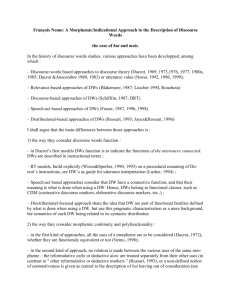
![[#JAXB-300] A property annotated w/ @XmlMixed generates a](http://s3.studylib.net/store/data/007621342_2-4d664df0d25d3a153ca6f405548a688f-300x300.png)
